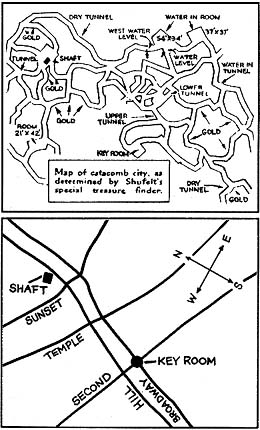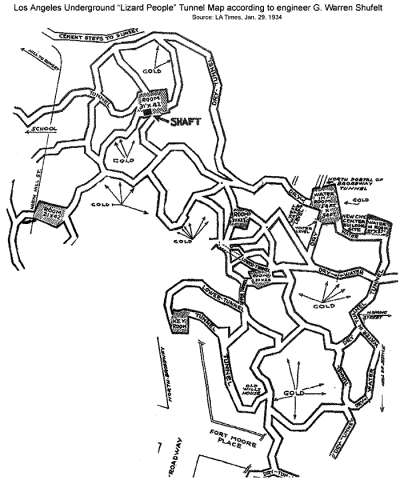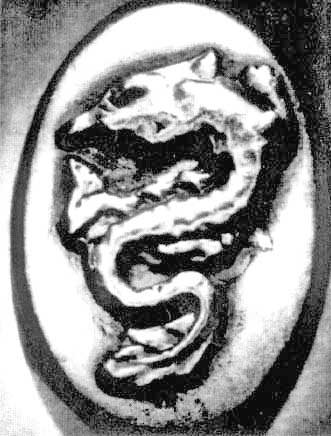|

by Robert Stanley
from
UnicusMagazine Website
According to the legend and the radio
surveys, the underground city was laid out in the shape of a lizard,
with its tail under the Main Library at Fifth and Hope.
In the summer and fall of 1933, a Los Angeles mining engineer named
G. Warren Shufelt was surveying the L.A. area for deposits of oil,
gold and other valuable materials, using a new device which he had
invented. Shufelt had designed and built a radio-directed apparatus
which he claimed was able to locate gold and other precious
resources at great depths. He believed that the radio device worked
on a newly discovered principle involving electrical similarities of
matter which had the same chemical, physical and vibrational
character.
His device appeared to consist of a large pendulum suspended in a
cylindrical glass case which was housed in a black box with
compasses on it. The pendulum would trace a line directly from a
piece of ore broken from a vein to the vein it was originally taken
from. Hair taken from a test subject would lead investigators to the
person who had donated the hair sample. It was said to have worked
even at a distance of many miles.
Although he would not tell exactly what was in the box, Shufelt
believed that by tuning into the individual frequency of a
particular material, he could locate similar matter. He believed
that the emanations and gravitational factors of matter influenced
the pendulum and that, in principle, no two separate things were
exactly alike. Shufelt was extremely puzzled when one day, while
taking readings near downtown Los Angeles, his instruments showed
him what seemed to be a pattern of tunnels which led from what is
now the Public Library in the heart of L.A. to the top of Mount
Washington and the Southwest Museum to the north in Pasadena.
He proceeded to draw a map and had it copyrighted. What he
discovered appeared to be a well planned underground labyrinth with
large rooms located at various points, and deposits of apparently
man made gold in the chambers and passage ways.
(click below image)

Some of the tunnels ran west for 20
miles under the Santa Monica Bay, which he believed were only used
for ventilation. Unfortunately, Shufelt had no idea that they were
connected to the older ruins of an even greater city which was
covered by the Pacific Ocean thousands of years ago during a
tremendous earthquake and subsequent flood.
The subterranean complex he had discovered was used for emergencies
and was only designed to accommodate 5,000 people or less. Food
supplies of imperishable herbs were stored in sufficient quantities
which would enable the survivors to live underground until it was
safe to come back to the surface. Valuable personal belongings and
utensils were also brought into the complex along with historical
records and gold treasures.
During his research, he met a Hopi Indian named Chief Little Green
Leaf, who told him about the legend of an ancient race of "Lizard
People". The legends said that about 4,000 to 5,000 years ago, an
enormous meteor shower fell on the western coast covering an area
hundreds of miles wide. Winslow crater in northern Arizona is only
one of the pieces that fell from the sky at that time.
Thousands of people were killed, their crops wiped out, dwellings
destroyed, and the forests set on fire. The surviving members of the
medicine lodge, which had remained on the west coast, met to make
plans for constructing safe areas. The sentinels of the sky gave
their warning that it was time to enter the shelters and seal the
shafts behind themselves. They were forced to go underground to save
them selves from a gigantic meteor shower which devastated most of
the west coast of the US.
The "Lizard People" of Los Angeles survived the meteor shower, but
were killed by natural gas leaking into their bunkers. Shufelt
believed that they had built 13 such underground facilities in
different areas for such a purpose. One was located in the eastern
section of Arizona in a small town called Springerville and was only
discovered recently. Another was located under a hill which was
surrounded by a curving ridge of mountains like the middle of a
horse's hoof. This is exactly the type of terrain seen in downtown
L.A. in the area that is now the Board of Education, which is built
over the ruins of the old Willis Estate on top of Fort Moore hill.
Shufelt and his partner Chief Little Green Leaf were both convinced
that the ancient legends and the readings from Shufelt's mystery
machine were true.
They decided to obtain a permit to sink a shaft down into the ruins
of the subterranean city. They located a vacant lot at 518 North
Hill Street, directly above one of the largest rooms. On 21st
February 1933, the County Board of Supervisors approved a contract
with Rex McCreary, Warren Shufelt and Ray Martin to search for
buried treasure there. The permittees were to bear all expenses, to
leave the property in its original condition, and to share 50% of
all discoveries and treasure with the city of L.A.
The county originally only allowed them to dig up to depths of 50
feet for fear of cave-ins. On 27th March 1933 they requested
additional time and depths on their permit, believing that the
labyrinth of tunnels was at least 1,900 feet in length, with rooms
containing 9,000 square feet which contained valuable gold treasure
in at least 16 places.
On 10th April 1933 the contract was renewed. By the end of November
in 1933, the main shaft was at a depth of 200 feet. Shufelt was
determined to drill to a depth of 1,000 feet if necessary. On 29th
January 1934, the first stories regarding the legend of the "Lost
Land of the Lizard People" made the L.A. newspapers. By this time,
one of the five shafts was already 250 feet deep.
According to the legend and the radio surveys, the underground city
was laid out in the shape of a lizard, with its tail under the Main
Library at Fifth and Hope, and the body extending Northeast, with
the head being at Lookout and Marda near North Broadway. The key
room to the city was located under Second and South Broadway. The
legends state that the key room is the directory to the rest of the
city, and to the historical gold record tablets. These gold tablets
were slabs of gold, 4 feet long and 14 inches wide.
The tablets were believed to contain the records of the origins of
the human race, and the history of modern man in the Americas,
including details regarding the history of the mysterious Mayan
people. Shufelt's radio-wave machine mapped the rooms and tunnels as
subsurface voids, with the gold slabs as dark areas, showing perfect
geometric angles.
The rooms, seven of which occurred within an area of six square city
blocks, varied in size from 23' x 23' to 34' x 42'. The room below
the first shaft was 31' x 42', and the key room was the smallest.
Water had seeped into some of the tunnels, and several of the rooms
including the largest were flooded. Shufelt was prepared to use
divers to explore the submerged areas when they finally broke into
the subterranean city. Chief Little Green Leaf claimed that the
"Lizard People" had been able to predict earthquakes and that he had
also been able to do so.
He had accurately predicted the destruction of the Long Beach quake
on 10th March 1933, a month in advance. He believed that it was easy
for anyone to tell 96 hours in advance when an earthquake was
coming, because the needle on a compass would become demagnetized
and refuse to point north. By the beginning of February 1934, the
first shaft had reached a depth greater than 250 feet and was still
being dug, despite difficulty caused by the water encountered in its
path.
Several newspaper articles featured updates on the project. Shortly
after all the media attention was focused on this search for the
lost city under L.A., the project was suddenly stopped and
abandoned. On 5th March 1934, the shafts had been filled in and the
contract with the city was canceled. Neither gold nor any other
treasure was ever turned over to the County of Los Angeles.
Mr. Arche Dunning of the Los Angeles Chamber of Commerce stated in
December of 1947 that,
"It is quite possible, of course, that the
supposed labyrinth really exists. But in view of the fact that the
overlaying area is the immediate Civic Center area where an
important building program is to be carried out, including federal,
state, county and city building, there is little probability of any
further excavations."
This is really not a true statement because it is necessary to
excavate many hundreds of feet into the ground before a high-rise
building can be constructed. Also, one should consider that sewage
systems are all underground. And let's not forget the new Metro Rail
System, which rises up from many feet below the Civic Center before
it speeds commuters on their way. Long ago even the Chinese dug
tunnels around the area which is now the train yard.

These red brick subsurface tunnels were used for their safe passage,
from one end of Old Chinatown to the other and are now an historic
landmark found preserved at Alvera Street. It is quite possible that
there is another city below the L.A. Civic Center which only a small
number of people have access to. The question is, who?
Reference and
further information
LIZARD PEOPLE UPDATE
Dear Duncan,
Here is a reptilian relic that was found in Los Angeles in
1954
that neatly fits into the "Lost Land of the Lizard People"
article [see
NEXUS 2/19]. Enclosed is a photo of an artifact
that is definitely very old, depicting a full-bodied dragon.

The upper section of the medallion
is made of pure silver that was somehow fused to a copper-alloy
base which is composed of over 40 different types of metal. The
medallion's actual dimensions are 7/8" (width) x 1/4" (length) x
1/l6" (depth).
The man who found it, Mr. G., was an aerospace engineer who
lived and worked for the US Government in Chatsworth,
California. The artifact was found while Mr. G. was helping a
friend, who lived on the northern shore of Chatsworth Reservoir,
repair the wooden stairway to the front porch. Mr. G. dropped
his hammer, which fell into a soft sandy area, and when he
reached to pull his hammer out he noticed this small metal
medallion.
Mr. G. still has the artifact in his possession, and after much
research feels that it belonged to an ancient race of space
people named ALTEC, who left behind their influence on this
world long ago. The Friendly or Sleeping Dragon is a very old
symbol, one which has definite connections to UFO's.
I once had the opportunity to show a picture of a Pleiadian-style UFO to a man from
Bhutan (near Tibet) and asked if he had
ever seen such a thing. He replied that yes, they did see them
often and that they were called "Friendly Dragon".
Chatsworth is located in Los Angeles County near the northwest
border of the city and county lines. It is likely that a Chinese
laborer lost this artifact while working in Chatsworth on
railroad construction, around the turn of the century. There is
a railroad tunnel that was cut by the Chinese through a solid
red rock ridge called the Santa Suzana Pass near the Chatsworth
Lake. Old Chinatown is located in downtown Los Angeles and was
built where the new rail-yard now sits.
New Chinatown is built over much of the old tunnel systems that
the first Chinese leaders had constructed for their 'safety'
when they first arrived in the area. It is possible that
engineer/inventor G. W. Shufelt did not know what he had
stumbled onto electronically, and it is also logical that
Chinese people would not admit to the existence of a secure
system of tunnels and rooms they had worked so hard to build in
secret.
There may even have existed a series of older tunnels and rooms
that the Chinese discovered during their own excavations and
construction. However, the Federal Government definitely stepped
in during the '50s and took control of the entire underground
tunnel system for their Cold War operations, adding many new
paranoid-influenced improvements over the years that followed.
In the '9Os, two suspicious arson fires were started as a
distraction while ONI (Office of Naval Intelligence) operatives
gained access to the secret entrance that Shufelt located in the
basement of what is now the main library. There is more to this
story than can be told at this time.
Take care, and keep up the great work with NEXUS magazine.
Sincerely,
Robert Stanley
Editor
Unicus Magazine
|



